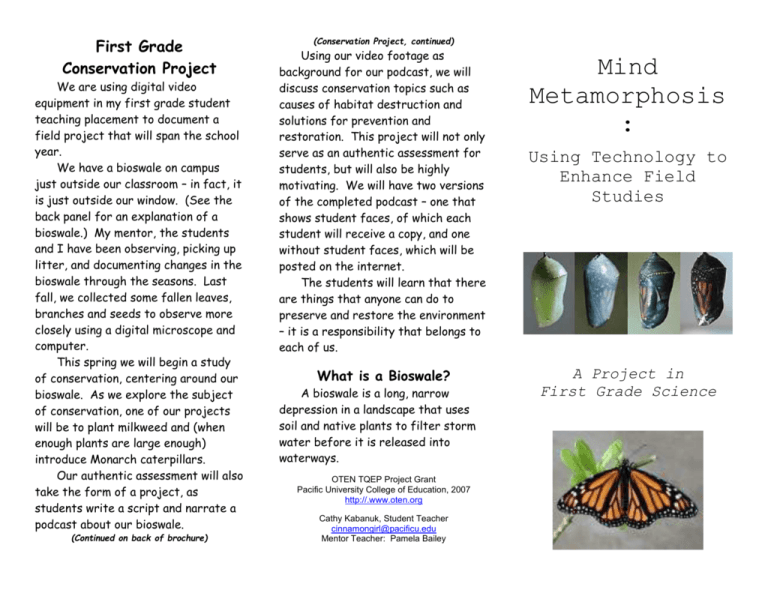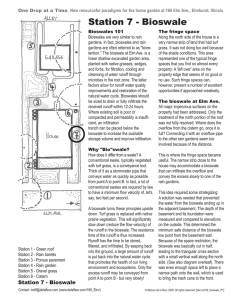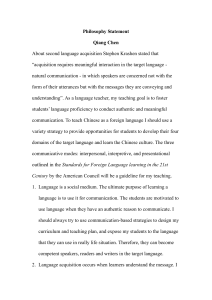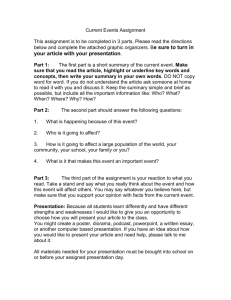First Grade Conservation Project We are using digital video
advertisement

First Grade Conservation Project We are using digital video equipment in my first grade student teaching placement to document a field project that will span the school year. We have a bioswale on campus just outside our classroom – in fact, it is just outside our window. (See the back panel for an explanation of a bioswale.) My mentor, the students and I have been observing, picking up litter, and documenting changes in the bioswale through the seasons. Last fall, we collected some fallen leaves, branches and seeds to observe more closely using a digital microscope and computer. This spring we will begin a study of conservation, centering around our bioswale. As we explore the subject of conservation, one of our projects will be to plant milkweed and (when enough plants are large enough) introduce Monarch caterpillars. Our authentic assessment will also take the form of a project, as students write a script and narrate a podcast about our bioswale. (Continued on back of brochure) (Conservation Project, continued) Using our video footage as background for our podcast, we will discuss conservation topics such as causes of habitat destruction and solutions for prevention and restoration. This project will not only serve as an authentic assessment for students, but will also be highly motivating. We will have two versions of the completed podcast – one that shows student faces, of which each student will receive a copy, and one without student faces, which will be posted on the internet. The students will learn that there are things that anyone can do to preserve and restore the environment – it is a responsibility that belongs to each of us. What is a Bioswale? A bioswale is a long, narrow depression in a landscape that uses soil and native plants to filter storm water before it is released into waterways. OTEN TQEP Project Grant Pacific University College of Education, 2007 http://.www.oten.org Cathy Kabanuk, Student Teacher cinnamongirl@pacificu.edu Mentor Teacher: Pamela Bailey Mind Metamorphosis : Using Technology to Enhance Field Studies A Project in First Grade Science Mind Metamorphosis: Using Technology to Enhance Field Studies Field investigations and projects are powerful, authentic learning experiences for students. Textbooks, worksheets, and videos, though they have their places, cannot facilitate learning in the way that engaging the senses in real-life exploration does. Challenges When planning a field project with students, teachers must consider how they will meet a number of challenges. These include how to: Document field activities and discoveries – taking notes or filling out worksheets is difficult in the best conditions, and not possible for younger students; Gather specimens to work with in the classroom – depending upon the study, this could be inconvenient, unethical, or impossible; Bring together students’ individual or small group experiences in the field for the entire class to draw upon; Help students remember important experiences or discoveries after returning to the classroom; Organize various components of long-term investigation into a total picture to meet learning goals; When gathering specimens is inconvenient or unethical, video provides an alternative; Review the overall project for assessment – can be difficult if it is necessary to rely on memories and field notes. Students’ individual and small group experiences and discoveries can easily be shared with the entire group. Solutions Use of technology can greatly enhance the learning experience provided by field activities. Teachers can make digital video recordings of the investigations and activities to track progress and provide a medium for overview of the entire project. Creation of a movie or podcast, using video as well as related investigations and oral reports based on research, can be used as an authentic assessment in a culminating project. Advantages Digitally documenting fieldwork has a number of advantages for teachers and students, such as: Documenting students’ experiences and discoveries in the field is easier, less messy, and more accurate than using paper and pencil; It provides the opportunity to regularly review a project as it progresses and allows students to scaffold on earlier discoveries and tie various parts of the project together into a coherent finished product; It helps to activate recall, and facilitate class discussion, and contributes to review of the overall project; Video recording and creation of podcasts can be more motivating to students than simply writing a report and giving an oral presentation to the class. Summary One excellent way to represent the overall field project is to bring the components together into a finished product. As students and teacher work together to create a podcast from the digital data, new insight is fostered and new questions are generated. Students now have an authentic reason for researching their own questions, which enhances motivation. The concepts are further reinforced as students create and read the script. In the process, students also learn how to use technology in a way that is authentic and provides them with a medium for fostering creativity as well.






